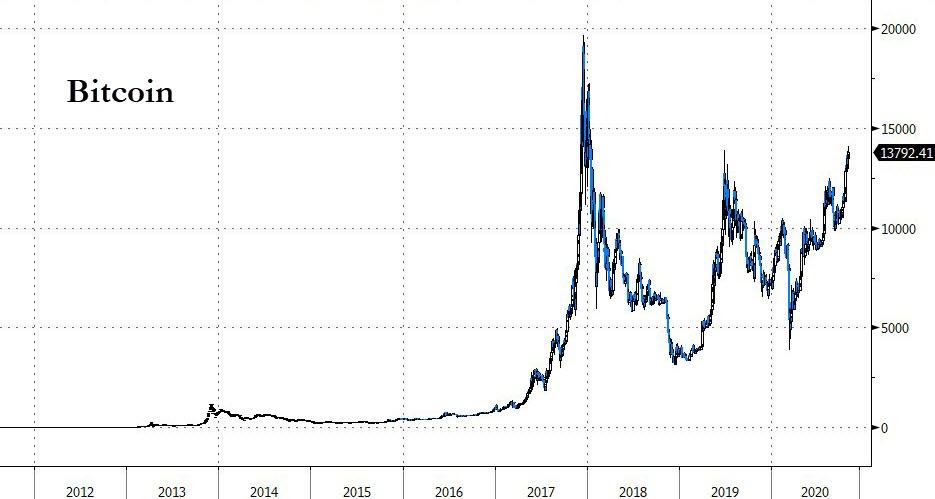What's Happened To Bitcoin Since Its Whitepaper Appeared 12 Years Ago? Tyler Durden Sat, 10/31/2020 - 20:30
Authored by Robert Stevens via Decrypt.io,
In brief
-
On October 31, 2008, Satoshi Nakamoto published the Bitcoin whitepaper.
-
Since then, Bitcoin's journey has taken in highs and lows, from the Mt. Gox hack to an all-time high price of $20,000.
-
In 2020, it's seen renewed growth in the face of the coronavirus pandemic, as institutional investors take a growing interest in the cryptocurrency.
Today marks the 12th birthday of the Bitcoin whitepaper. There will be no party, no cake: Bitcoin’s friendship network is decentralized, and its creator anonymous. Yet, since its release, the whitepaper has had a profound impact on the world.
What’s happened? Let’s go year by year:
2008: the birth of Bitcoin
On October 31, 2008, our story began. Satoshi Nakamoto, a pseudonym of Bitcoin’s anonymous creator—or team of creators—releases the whitepaper for Bitcoin: A Peer-to-Peer Electronic Cash System. In it, Nakamoto sketches a plan for a system that allows “online payments to be sent directly from one party to another without going through a financial institution.”
The previous month, Lehman Brothers, one of the largest investment banks in the US, collapsed as a result of the 2008 financial crisis. This was Bitcoin’s raison d'être—as the centralized US financial system ran into trouble, a gap in the market opened for a decentralized system that bypassed its burning wreck.
2009: Bitcoin’s first year
2009 marked the release of Bitcoin. In January, its code was released as open-source software, and the genesis block—Bitcoin’s first block—was mined. Nakamoto mined the first 50 bitcoins, though they weren’t worth anything at the time. A few weeks later, Nakamoto sent Hal Finney 10 Bitcoin in the first Bitcoin transaction between two individuals. As Bitcoin turned one, Wikileaks published 400,000 documents about the Iraq war, and the Times Square Bomber—who failed to detonate in the New York City tourist hotspot—was sentenced to life in prison.
2010: Bitcoin Pizza Day
Bitcoin shared its 2010 birthday with Instagram; the photo-sharing app launched on October 6. In 2010, Bitcoin was worth around $0.20, and hit highs of $0.39 during the year. Nakamoto, who had mined around one million Bitcoins at the time, passed over the keys for Bitcoin’s code repository to Gavin Andresen. 2010 also marked Bitcoin Pizza Day: on May 22, Laszlo Hanyecz paid 10,000 Bitcoins for two pizzas from Papa John’s. At current prices, that’s over $137 million.
The #BitcoinPizza would be worth US$137,558,701.15 right now (up 3.56352655% in the last 24 hours) #Bitcoin
— Bitcoin Pizza (@TheBitcoinPizza) October 31, 2020
Years later, Hanyecz was sanguine about his multimillion-dollar purchase, telling the New York Times that, “It wasn’t like Bitcoins had any value back then, so the idea of trading them for a pizza was incredibly cool [...] No one knew it was going to get so big.”
2011: The first Bitcoin bubble
Bitcoin took off in 2011—and it didn’t take long for the black market to take note of its supposed anonymity, with Silk Road, the dark net market which traded Bitcoin for guns, drugs, and other illegal contraband, opening for business..
2011 was also Bitcoin’s first bubble: Bitcoin skyrocketed in price, rising to $31.50 on June 8, but by Bitcoin’s third birthday, its price sunk to $3.12; an early sign of the volatility that continues to affect the cryptocurrency to this day.
Bitcoin was also met with competition on its third birthday: Litecoin, the “silver to Bitcoin’s gold,” launched in October 2011. Elsewhere in the world, Libyan dictator Muammar Gaddafi was killed as part of the Arab Spring uprising.
2012: Blackout, schmackout
October 31, 2012 marked something of a triumph for Bitcoin; on that day, the New York Stock exchange opened up again after closing for two days as a result of Hurricane Sandy. Bitcoin remained operational throughout, providing ample evidence of the power of its decentralized network.
Bitcoin’s price continued to grow throughout the year: by October, it reached highs of $12.4. Its price, which averaged $5.27, was a 1,656 percent increase from 2011.
In September, the Bitcoin Foundation was started, headed by Gavin Andresen, Jon Matonis, Patrick Murck, Charlie Schrem, and Peter Vessenes. BitPay, the Bitcoin payments service, announced that 1,000 merchants started accepting payments through Bitcoin.
2013: Silk Road seized
In February 2013, Coinbase reported sales of over $1 million, and in March, Bitcoin’s market capitalisation surpassed $1 billion. Silk Road, which opened in 2011, was seized by the FBI in October, along with 26,000 Bitcoin; its founder, Ross Ulbricht, is now serving a double life sentence without parole; in 2020, he marked his seventh consecutive birthday in prison. Prosecutors said that, from 2011-2013, sellers on Ulbricht’s site made over $214 million.
By its third birthday, Bitcoin’s market cap had surpassed $2 billion and the price for a single Bitcoin was over $200. Elsewhere in the world, Peter Higgs and Alice Munro win Nobel Prizes.
2014: Mt. Gox collapses
By Bitcoin’s sixth birthday, its market cap is over $4 billion, the price of a single Bitcoin is $329, and its daily volume is over $13 million. But not all is well in Bitcoin world: back in February, the cryptocurrency exchange, Mt. Gox stopped accepting withdrawals after 744,000 Bitcoins went missing; around $473 million, or 6 percent of the Bitcoin supply. Around 200,000 of those Bitcoins have been recovered, though the rest are gone.
2015: Volume up
By the end of October 2015, Bitcoin’s market cap was $4.6 billion, and the price of a single Bitcoin was $312. Though the price and market cap stagnated, Bitcoin’s daily volume skyrocketed to $52 million. Outside of Bitcoin, China started to build islands in the South China Sea, and Russia got involved in the Syrian war.
2016: Bitcoin goes mainstream
In 2016, the price of Bitcoin begins to grow. On its whitepaper’s birthday, its 24 hour volume hit $93 million, its market cap $11 billion, and the price of a single Bitcoin, $703. Many more high profile businesses start accepting Bitcoin, including Valve’s Steam video games store and ride-sharing service Uber.
In October, Colombia signed a peace agreement with FARC rebels, and Kim Kardashian had $10 million stolen from her in a hotel room in Paris. If only she’d kept it in Bitcoin...
2017: The Bitcoin bubble
2017 ushered in a new US President in Donald Trump, but for cryptocurrency holders, it was the year of the Bitcoin bubble.
On the birthday of the Bitcoin whitepaper, one Bitcoin was worth $6,131, and its market cap was over $100 billion—a figure that some attribute to the Chicago Mercantile Exchange’s listing of Bitcoin futures contracts, which made it far easier for the world to bet on Bitcoin. CME traded $460 million in its first week. This price was to skyrocket to over $20,000 in December. On December 7, almost $50 billion worth of Bitcoin was traded.
2018: Down, but not out
In 2018, everything came crashing down. The market, based purely on speculation, flipped, and Bitcoin fell to $6,538 in February. The cryptocurrency muddled through a tough year: on the 10th anniversary of its whitepaper, the price of Bitcoin was $6,325. While its market cap remained strong, at $109 billion, the crypto crash prompted a backlash from mainstream publications and social media.
Twitter, Facebook, and Google duly banned advertisements for cryptocurrencies, including Bitcoin. Google and Facebook have since lifted the ban, with Facebook going all-in on crypto as it tries to get its own digital currency, Libra, off the ground.
2019: Bitcoin’s back, baby
In 2019, the market came rushing back, following further price drops in 2018. Bitcoin started the year at $3,764, and its price skyrocketed to $13,796 in July. Since then, its price waxed and waned, but held relatively strong, boosted by Chinese President Xi Jinping's endorsement of its underlying technology, blockchain.
On its 11th birthday, Bitcoin cost around $10,000, and its market cap was around $165 million. By that point, the Bitcoin network comprised over 55,000 nodes, while over 820,000 addresses had traded Bitcoin.
2020: New heights
Ah, 2020. Bitcoin started off strong, as excitement mounted for the imminent Bitcoin halving. But few could have foreseen how the year would pan out, as the coronavirus pandemic gripped the world in March. The chaos initially throttled the price of Bitcoin, with the cryptocurrency dropping to lows of $4,000.
But as massive stimulus packages followed lockdowns around the world, Bitcoin began to come into its own, with investors seeking it out as a hedge against inflation. Bitcoin’s price reached around $10,000, and stayed there for the remainder of the summer. The series of financial shocks endured by the world economy seemed to prove the case that Bitcoin is antifragile—not only resistant to shocks and stresses, but stronger for them.
Then the big money started to pour in; institutional investors such as Grayscale and Square scooped up vast amounts of Bitcoin, and digital payments giant PayPal introduced crypto buying and selling features, opening the door to mass adoption of the cryptocurrency.
The news sent the price of Bitcoin soaring past $13,000; on the 12th anniversary of the Bitcoin whitepaper, it reached its highest price since 2018. Those who'd previously bashed Bitcoin, from Grayscale CEO Michael Saylor to JP Morgan, fell over themselves to sing the cryptocurrency's praises.
#Bitcoin is a swarm of cyber hornets serving the goddess of wisdom, feeding on the fire of truth, exponentially growing ever smarter, faster, and stronger behind a wall of encrypted energy.
— Michael Saylor (@michael_saylor) September 18, 2020
One thing's for certain: whatever happens next, Bitcoin is in a very different place from when it first emerged into the world, 12 years ago.
https://ift.tt/3jPzHJM
from ZeroHedge News https://ift.tt/3jPzHJM
via IFTTT






0 comments
Post a Comment